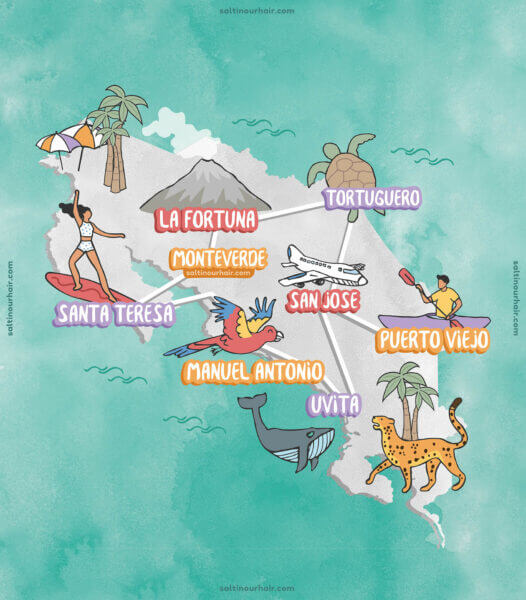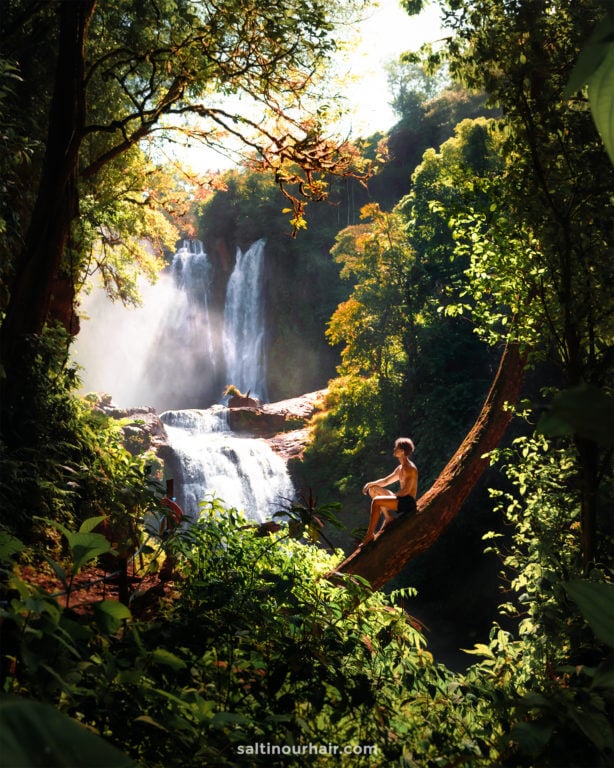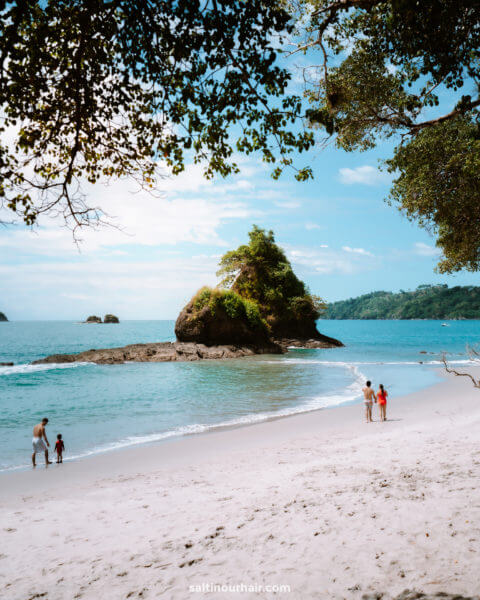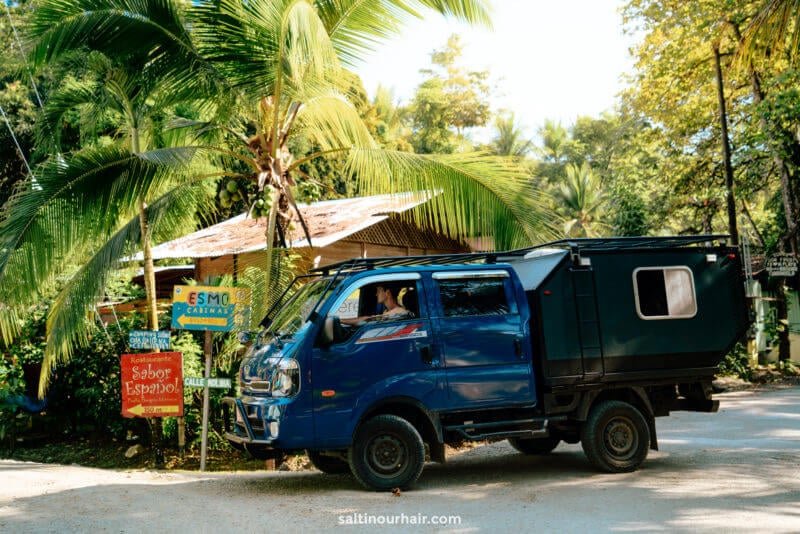
Map of Costa Rica
Weather in Costa Rica
Costa Rica's diverse microclimates make the weather fairly unpredictable; one moment may be hot and sunny, and the next, pouring down! The driest months are between mid-December to April, and the wettest are May to November, but don't be deterred by the rainy season; nature becomes incredibly luscious, and costs will be lower.
- Find Hotels via Booking.com
- Find Hostels via Hostelworld
- Find a Rental Car via Sunny Cars
- Find Flights to Costa Rica via Skyscanner
- Get a Travel Insurance via Heymondo
- Book Tours & Attractions via GetYourGuide
- Book a Bus/Train/Transfer via 12Go
- Get a Visa via iVisa
- How to pack light for your trip
- How to plan your trip our tips
Costa Rica is a tropical haven of stunning natural beauty, where “Pura Vida” is not just an expression but a way of life. With its unspoiled coastlines, lush jungles, captivating history, exhilarating adventures, and an incredible abundance of wildlife, it’s a magical destination waiting to be explored!
Due to Costa Rica’s increase in popularity in recent years, prices have been on the rise, earning the nickname ‘Switzerland of Central America’. While budget-friendly options are available, expect to spend, on average, $860 – $2650 USD per person per week.
Tap water is typically safe to drink in most parts of Costa Rica, so bring a reusable water bottle or buy a 10-liter water bottle at the supermarket to refill throughout your trip.
Most passport holders do not require a visa to enter Costa Rica for 90 days. However, you will need a valid passport and an onward plane ticket to prove that you will leave within this time. Check your country’s entry requirements in advance.
In Costa Rica, Spanish is the language spoken throughout the country. While English is often spoken in popular tourist areas, known basic Spanish phrases will be helpful, particularly if you head off the beaten path.
While exploring this paradise, travel insurance will give you peace of mind. It’ll protect you against medical emergencies, flight cancellations, and lost belongings, ensuring you can fully immerse yourself in Costa Rica’s wonders.
Generally, Costa Rica is a very safe place to travel, with welcoming locals and the lowest violent crime rate in Central America. Petty crime does exist, so as with all destinations, stay vigilant and keep an eye on your belongings at all times.
Costa Rica uses plug types A and B, which operate on 120V. Bring an adaptor, or buy one at the airport to stay connected during your vacation in Costa Rica.
Costa Rica is loved because of its connection with nature, breathtaking landscapes, vibrant culture, and “Pura Vida” way of life. With lush rainforests, active volcanoes, pristine beaches, and a diverse ecosystem, it really is an incredible place to explore!
Travel to Costa Rica
A paradise for nature enthusiasts and adventure seekers, Costa Rica is a small but incredibly diverse country, where “Pura Vida” isn’t just a saying, it’s a way of life. A place where sloths slowly make their way through the lush rainforest canopies and baby turtles take their first steps in the sand; Costa Rica has it all!
How to plan your trip to Costa Rica
Check our Costa Rica travel guides for an incredible adventure! Whether you’re camping with a 4×4, backpacking around the country, or looking for a relaxing getaway, we’ve got you covered with all the best things to do in Costa Rica.
Looking for more detailed day-to-day itineraries? Our Travelers Guide to Costa Rica could be perfect for you!
Best time to visit Costa Rica
As a tropical country with over 20 micro-climates, the weather in Costa Rica can change in a matter of minutes – you may go from basking in 30°C sunshine one moment to experiencing a refreshing 18°C rain shower the next.
Dry Season (mid-December – April): The best time to visit Costa Rica is between mid-December and April, the driest and sunniest time of the year. Even though this is the dry season, as the climate in Costa Rica is tropical, you could still be in with the chance of a rain shower here and there. Although these months bring more crowds and increased prices, this is the ideal time to visit for beach lovers and beginner surfers.
Rainy Season (May – November): The months between May and November are the rainy season, with October being the wettest month to visit. Don’t let this put you off vacationing in Costa Rica; the rain showers never usually last long, nature becomes incredibly vibrant, prices are lower, and it makes for the perfect waves for intermediate surfers!
Best time to visit Costa Rica for wildlife: Wildlife is abundant year-round thanks to Costa Rica’s conservation efforts, but if you’re keen to spot specific wildlife, there are prime seasons to keep in mind. Humpback whales can be observed from December to April on both the Pacific and Caribbean coasts, as well as from July to November on the Pacific side. Green nesting turtles make an appearance from July to October, and leatherback turtles emerge between February and April. The ideal bird-watching period is during October and November.
Whatever time you choose for your Costa Rica holiday, whether you’re pursuing a particular animal, searching for the best waves, or looking for relaxing beach days, this tropical paradise has it all!
Coastlines and beaches in Costa Rica
With over 300 beaches, Costa Rica’s coastline ticks all the boxes! Whether you’re a wildlife enthusiast looking to chill with iguanas, a keen surfer chasing the perfect wave, or you want to relax in unique tidal pools, Costa Rica has it all.
For one of the best places in Costa Rica for surfing, head to Santa Teresa, a charming bohemian beach town lined with palm trees. Nearby, at Playa Manzanillo, experience the wind in your hair horseriding barefoot down a deserted beach. For unspoiled beauty, Manuel Antonio offers some of the best beaches in Costa Rica, where you’ll find powdery white sand with abundant wildlife on the shores thanks to its location next to the renowned national park.
Looking for something a little off the beaten track? Uvita is one of the best places to travel in Costa Rica. Rocas de Amancio Beach is a local hidden gem and the perfect place to watch the sunset. Or visit Marino Ballena National Park, known for its extraordinarily shaped beach resembling a whale tail.
With a choice of the Caribbean or Pacific coast, Costa Rica isn’t short of incredible beaches to visit, many of which are still relatively undiscovered. The ocean is an integral part of Costa Rican life, with a clear commitment to preserving the marine life and wildlife around it; it really is a special place.
Food, culture, and religion in Costa Rica
With a vibrant fusion of influences and ethnicities, the local population, known as “Ticas” and “Ticos”, are renowned for their warm hospitality and easy-going, “pura vida” approach to life. Art, music, and dance are expressions of their culture, noticeable through the many festivals yearly, such as Fiestas Palmares and endless colorful streets and markets. Whilst Roman Catholicism is the main religion, Costa Rica is renowned for its inclusivity, harmoniously living together, paying homage to their laid-back attitudes.
Costa Rican cuisine is a delightful blend of flavors, using simple, mild, and fresh ingredients, steering clear of processed food. Rice and beans are a staple of most diets, with Gallo Pinto being the national dish. Fresh seafood, such as ceviche and arroz con mariscos, is always an option, thanks to Costa Rica’s extensive coastline. Because of its tropical climate, there is an abundance of fresh fruit, such as mango, papaya, and pineapple.
Coffee also plays an integral part in the country’s economy, having some of the best flavor profiles in the world. If you’re a coffee enthusiast, don’t miss the opportunity to join a coffee tour to learn all about the production process and enjoy some tasty samples during your Costa Rica holiday.
Why you should travel to Costa Rica
There’s nowhere quite like Costa Rica, a country full of unrivaled natural beauty and somewhere every traveler should visit at least once. From the natural hot springs in La Fortuna to the pristine beaches of Manuel Antonio and the Cloud Forest of Monteverde, Costa Rica is a paradise for nature lovers and adventurers.
For environmentally-conscious travelers and animal lovers, Costa Rica is a global leader in sustainability and ecotourism, making significant efforts to protect nature and wildlife. You can visit national parks, conservation centers, and wildlife reserves; by visiting, you’re supporting the efforts to preserve this breathtaking environment.
For adrenaline junkies, Costa Rica’s diverse terrain is a playground with no end of thrill-seeking activities, such as white water rafting, waterfall rope swings, scuba diving, and ziplining above the treetops. Or if you’re looking for the “pura vida” lifestyle, there are plenty of laid-back things to do; the options are endless!
The beauty of Costa Rica isn’t confined to its wildlife and landscapes. The warm welcome from the locals gives a feeling that can’t be described; you have to experience it for yourself. Every day is filled with beautiful moments and simple pleasures, making for an unforgettable journey.
Safety and travel advice Costa Rica
Costa Rica is known to be one of the safest countries in Central America for tourists, with some of the friendliest locals in the world.
Crime and Safety in Costa Rica: Like most Latin American countries, Costa Rica does have a few problems relating to drug trafficking, poverty, and pickpocketing, especially in busier areas like San José. Always stay vigilant, keep your personal belongings secure, and avoid walking alone in poorly lit or remote areas at night.
Natural Disasters: Due to its tropical weather and microclimates, Costa Rica may experience natural disasters, with several active volcanoes and a risk of earthquakes, hurricanes, and flooding. These occurrences are rare, and the country is well-prepared, so always follow the advice of the local authorities.
Traffic and Driving: If you plan to rent a car in Costa Rica, be cautious of the roads. While nowhere near as bad as they used to be, road conditions can vary, and sometimes, a 4×4 is required to get somewhere safely. Always pay attention to signs, stay alert, and adhere to speed limits to ensure a safe experience on the road.
Travel Insurance: Travel insurance is recommended for all your travels. Purchasing insurance before your vacation in Costa Rica will provide peace of mind for your trip.



















